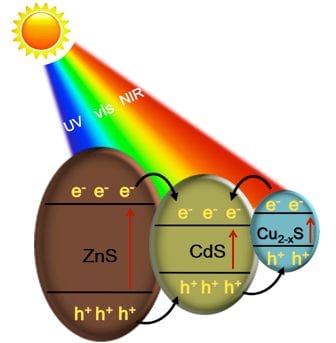Solar radiation is by far the most abundant source for clean and sustainable energy. Effectively harvesting solar energy to drive semiconductor materials for the production of other energy forms, such as chemical energy, electricity and thermal energy, is an ideal tactic to conquer the growing worldwide energy crisis. The full harvest of solar energy by semiconductor in light conversion requires such a material to simultaneously absorb diverse spectrum ranges of solar radiation and collect photo-generated electrons and holes separately.
To address this, a team led by Prof. Shu-Hong Yu and Prof. Jun Jiang at the Hefei National Laboratory for Physical Sciences at Micrscale (HFNL), Department of Chemistry, University of Science and Technology of China (USTC), has recently constructed a unique ternary sulfide -[ZnS-CdS-Cu2-xS]-ZnS- heteronanorod, one ZnS nanorod with segmented CdS node sheaths integrated by Cu2-xS sections through a colloidal chemical transformation strategy. The synthesized ternary heteronanorods show an expanded absorption region, including UV, vis and NIR. The formation of nonstoichiometric copper sulfide Cu2-xS can provide free holes in the valence band, inducing LSPR effect and consequently achieving NIR absorption. More importantly, selective incorporation of Cu2-xS on CdS domains results in staggered gap alignment due to pn heterojunction formation between CdS and Cu2-xS, further as verified by first-principles simulations. This ensures the delivery of photo-generated electrons in such a ternary system to the conduction band of CdS, while collecting holes of all semiconductor components in the valence band of Cu2-xS, promoting the electron-hole carriers separation. The integration of increased solar absorption and efficient charge separation leads to the performance improvement in solar energy conversion application.

Left: Energy band alignment and the flow of photo-generated carriers in ZnS-CdS-Cu2-xS nanosystem. The hybrid ternary ZnS-CdS-Cu2-xS is able to effectively absorb the ultraviolet (UV), visible (vis) and near infrared (NIR) light. The flow of photo-generated electrons is guided to the conduction band of CdS in this hybrid system, while the hole carriers are mostly accumulated at the valence band of Cu2-xS. Right: Schematic illustration depicting the ternary ZnS-CdS-Cu2-xS heteronanorods and TEM and HAADF-STEM images of heteronanorods. Inset shows the high-resolution HAADF-STEM image, ZnS: red, CdS: green, Cu2-xS: cyanine.
This multiple selective integration of p-type and n-type sulfides with variable band gaps but free of noble metals may provide a new horizon for enhanced full-spectrum solar energy absorption and efficient charge separation in the conventional semiconductor photoelectric field. This designed semiconducting hybrid system can be regarded as an important step toward a new generation of efficient solar cells covering the rainbow colors and beyond.
The results were published in Angew. Chem. -Int. Ed. as a VIP Paper (10.1002/anie.201601865) with the title of “Integration of Semiconducting Sulfides for Full-Spectrum Solar Energy Absorption and Efficient Charge Separation”, featured as front cover.
The research project is sponsored by the National Basic Research Program of China, the National Natural Science Foundation of China and the Chinese Academy of Sciences.

















